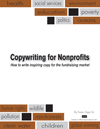Want to deepen the feelings of loyalty donors have toward your charity? Want the members of your association to feel more loyalty?
Have them imagine life without your nonprofit.
The suffering if your medical research had never found a cure . . . the children abandoned in the streets and turning to crime to survive . . . the veterans who struggled and failed to get through the maze of government forms and procedures to receive their benefits so now they end up living in poverty.
Or the association member who felt alone in the world and unsure of his business’ future until he joined your organization. Have him visualize what could have been: Losing his business and his dream. Struggling to find a job and having to take one he doesn’t like.
These imagines – a world without your nonprofit – invoke deeper emotional feelings on people. And it builds loyalty toward your nonprofit.
That’s just the way our human minds work. It’s called “counterfactual reflection.” That’s quite a mouthful but basically it means visualizing what would have been.
Jeff Brooks wrote about this in his blog, Future Fundraising Now – “Show donors the world without their giving.” It’s all based on a study called: Build Loyalty like George Bailey.
Be sure to read Jeff’s blog for more details on the study but the two main points Jeff made are these:
1 – Make it clear to donors what the world would be like without their gift
2 – Bad news raises more funds than good news
Again, the negative image (the alternate scenario) stirs deeper emotional feelings which result in greater feelings of loyalty. This is also another way to more donor-centric (reader-centric) copy.
Donors will feel a stronger connection to your charity when they clearly “see” what the world would be like without their gift. They’ll be more inclined to give and to give generously.
When you begin your letters or emails, consider a lead where you paint a vivid picture of the world without your nonprofit (the alternate scenario . . . the counterfactual reflection). Then introduce the role the donor plays and how they can help change that scenario which is also strong donor-centric copy. I agree with Jeff Brooks. You’ll raise more funds this way.

{ 3 trackbacks }
{ 2 comments… read them below or add one }
is this true for major donors? Repeat major donors? Or direct mail. Thanks
Hi Marjorie,
As with anything, you always have to test to see what works best for your organization and donors. That being said, I would certainly test it with major donors as well as mid-level and low-dollar donors. And it definitely applies to direct mail as well as online appeals.
Showing what the world is like without them, is a powerful way to demonstrate the impact their gift will have. Major donors want a meaningful experience with you; they want their gifts promptly acknowledged; they want reports and information on how their gifts have been used; they want to see how they’ve made a difference.
Recent studies also reveal that many major donors like to receive the same solicitations as other donors. Many nonprofits put them on a separate mailing schedule with different appeals once they become a major donor. They don’t all like that. Yes they can give more, but they don’t all want segregation. They enjoy receiving more of the mailings that prompted them to give so generously.
And don’t confuse any of my comments with the rapidly escalating importance of comprehensive stewardship programs for ALL donors. What’s required today goes FAR beyond a timely thank you letter.